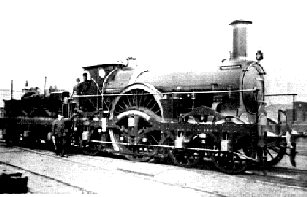Railways: George Stephenson -1781 - 1848 -

The "Rocket" built by G.and R. Stephenson in 1829.
Connecting rods from the pistons move the driving wheels.
The firebox at the rear of the boiler is fed with coal.
Exhaust steam from the cylinders is directed up the smokestak to create a heavy draft for the boiler fire.
This accounts for a locomotive's puffing.
The pistons and connecting rods supply power to the wheels on one side a quarter turn ahead of the wheels on the other side. This the locomotive is never caught "on dead center",that is, with all connecting rods straight forward or back and unable to turn the wheels.
Some reciprocating steam locomotives weigh 500 tons or more and develop more than 6,000 horse power. For extremely heavy loads or steep grades, two or more locomotives may be coupled to a train.
Full power is needed principally for starting a long train or for pulling up a steep grade.
When a train is rolling along on level track, only a few pounds of tractive effort will keep one ton of the train's weight in motion.
If the steam is admitted to each side of the cylinder troughout each stroke, the engine develops maximum power.
But usually this is needed only for starting. How gearing shifts the valves.
Like all great inventions, the locomotive grew trought the slow accumulation of improvements made by different inventors.
Men in England worked on the idea. Most of their devices were designed to run on ordinary highways, and so were forerunners of the automobile.
In 1804 R. Trevithick ran one of his road engines on rails in Wales. George Stephenson built a workable locomotive for the Killingworth colliery in 1815.
In 1825 his locomotives ran at the rate of 16 miles an hour on the new opened Stockton and Darlington Railway.
In 1829 Stephenson and his son Robert devised a multitubular boiler for the locomotive "Rocket".
The Rocket won a speed, pulling and endurance contest held by the Liverpool and Manchester Railway. This event is considered the birth of modern railroad.
Whith the traffic increase became a necessity to use signal apparatus: flag-signalling by day and beacon by night.
The Chappe's semaphore, used by railways in England in 1840, was invented at the end of 1700.
The electric telegraph solved many problems.

The "Smallow", english locomotive - 1849 -